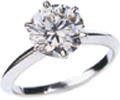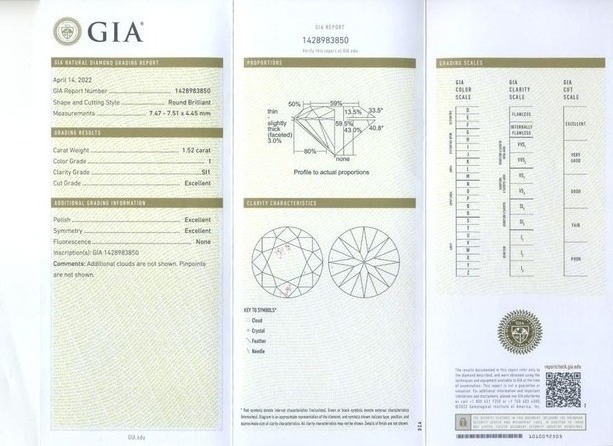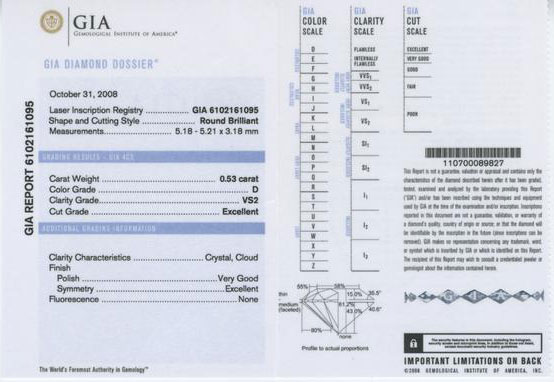Loose Diamonds
Diamond Guides
- The 4 C's and More
- Diamond Shape
- Diamond Cut
- Diamond Color
- Diamond Clarity
- Diamond Carat Size
- GIA Certification
- GIA Cut Grades
Jewelry Guides
- Engagement Ring Guide
- Diamond Tips
- Caring For Your Jewelry
- Tips on Getting Her Ring Size
- How To Build Your Fine Diamond Jewelry Wardrobe
- Diamond & Jewelry Appraisals
- Branded Diamonds
Education Videos
Design Your Engagement Ring
A. Fishman Difference
- Direct Diamond Prices
- Loose Diamond Manufacturer
- A+ Rating From BBB
- Customer Testimonials
- 100% Money Back Guarantee
- FREE FedEx Overnight Shipping
- Lifetime Warranty
- 2% Discount for Bank Wires
- Why No "Shopping Cart"
Expert Guidance
- Expert Guidance
- 212-869-0085
GIA Diamond Certification
Before purchasing a diamond, you should expect to review a copy of its GIA certification as proof that it has undergone an unbiased, professional examination. But not all gemological laboratories are the same and while their terminology is the same, the physical diamond may not be the same because they apply the standards more leniently or more strictly. This explains, in part, while certain diamonds which "appear" to be identical on paper are priced very differently and will have different values and desirabilities.
See Two Identical Diamonds-But with Different Prices?
What is a GIA Diamond Grading?
A GIA diamond certification issued by the Gemological Institute of America (GIA), also called a Diamond Grading Report or Diamond Dossier® is a report created by a team of gemologists. The diamond is evaluated, measured, and scrutinized using trained eyes, a jeweler’s loupe, a microscope, and other industry tools. A completed certificate includes a description of the diamond’s dimensions, clarity, color, polish, symmetry, and other characteristics. Many round diamonds will also include a cut grade on the report. It is a mechanically generated report and no judgment is made by the graders as to the desirability of the diamond.
100% GIA Certified Inventory - We Do Not Sell EGL Diamonds
Every loose diamond which A. Fishman & Son will sell you
Also See Two Identical Diamonds-But with Different Prices?
GIA Diamond Report Check
A Diamond Grading Report documents the specific characteristics of a diamond.
These reports are issued by the GIA, which is the most respected organization in the diamond industry. The GIA set the standard for diamond grading and gemological identification, and their grading system serves as the international gem and jewelry industry's benchmark credentials.
GIA Diamond Dossier
A Diamond Dossier®, issued by the GIA, is a special report issued for diamonds weighing less than 1 carat.
It does not contain a Clarity Plot showing where the inclusions are in the diamond. Instead, it lists the nature of the inclusions and has a Laser Inscription Registry inscribed in the diamond for identification purposes. Otherwise, it contains the same information as the full Diamond Grading Report.
Diamond Characteristics Documented in the Diamond Grading Report and Diamond Dossier® |
|
Shape: The diamond's shape is its form when viewed from above. See Diamond Shape Guide. Measurements: The Certificate lists the diamond's dimensions in millimeters. For a round diamond it is its minimum and maximum diameter and its depth. Clarity Grade: Clarity describes the degree to which blemishes or inclusions are present or absent in a diamond under 10x magnification. See Diamond Clarity. Depth: The height of a gemstone measured from the culet to the table. Depth %: The depth percentage compares the diamond's depth to its diameter. The ideal depth percentage depends on the chosen shape. Table: Located at the top of the diamond, the table is the largest facet of a diamond. Table %: The table percentage compares the width of the table to the width of the girdle. The ideal table percentage depends on the chosen shape. Girdle: Range of girdle thickness. The girdle is the faceted area which separates the top of the diamond (the "crown") from the bottom of the diamond (the "pavilion). Culet: Appearance, or lack thereof, of the culet facet. The culet facet is the pointed facet at the bottom of the diamond. In a diamond, that facet may not be present, in which case the culet characteristic is "None." Finish: Grades that represent a diamond's surface and facet placement. Proportion Diagram: A map of the diamond's actual proportions. A diagram is available on round diamonds graded after Jan. 1, 2006. |
Don't Rely Exclusively on a Certificate
It would be a mistake to rely solely on the diamond certificate when buying a diamond. See Beyond the 4 C's: What You Should Really Know Before You Buy a Diamond.
View Certificates While Shopping
If you are interested in a specific certified diamond at A. Fishman & Son you can view its certificate on our site before purchase.
View Photographs of Our Diamonds While Shopping
If you are interested in a specific certified diamond at A. Fishman & Son you can view an actual photograph of that diamond on our site before purchase.
Loose Diamonds
Shapes of Diamonds
Diamond Videos-New
About our Loose Diamonds
Perfect Diamonds
Pretty Diamonds
Round Cut
Princess Cut
Cushion Cut
Radiant Cut
Emerald Cut
Asscher Cut
Pear Shape
Oval Shape
Marquise Shape
Heart Shape
Diamond Jewelry
Brooches
Bracelets
Earrings
Engagement
Necklaces and Pendants
Wedding Rings
Custom Designed Jewelry
Diamond Guides
Diamond Guide - The 4 C's
Ethics of Lab-Grown Diamonds
Purchase: Beyond the Four C's
Diamond Guide Videos
Engagement Ring Guide
Understanding GIA Certificates
Understanding GIA Cut Grades
Pretty Diamonds
Diamond Clarity Enhancements
Conflict Free Diamonds
Identifying Fake Diamonds
Diamond Tips
Diamond Jewelry Appraisals
Diamond & Jewelry Care
Gift Giving
Beyond the 4 C's
Jewelry and Diamonds to Wear for a Lifetime - Not Just a Season!™
 A. Fishman & Son • 580 Fifth Avenue, Ste 402 • New York, NY 10036 • 212-869-0085
A. Fishman & Son • 580 Fifth Avenue, Ste 402 • New York, NY 10036 • 212-869-0085
Copyright © 2011-2022 A.Fishman & Son. All Rights Reserved. Website by YLWConsulting






